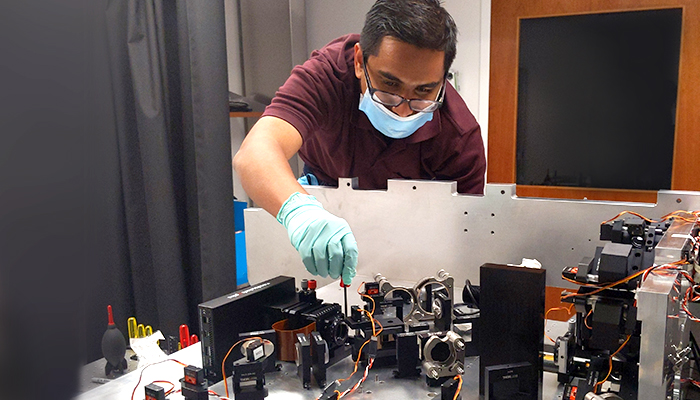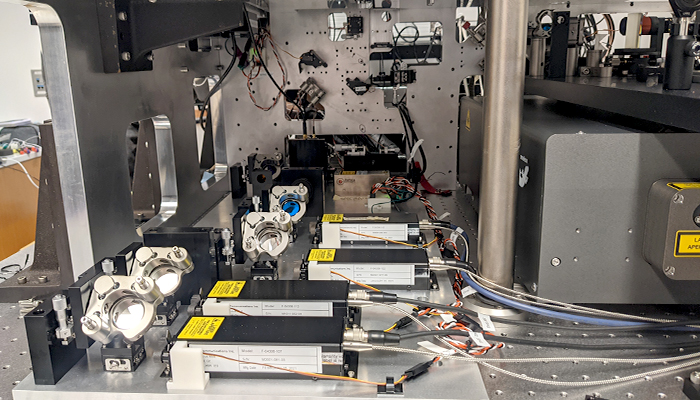HOW CAN WE HELP YOU? Call 1-800-TRY-CHOP
In This Section
New Innovator Award Advances Live Imaging Technology to See Embryonic Gene Regulation
mccannn [at] chop.edu (By Nancy McCann)

The Mir Lab, including Apratim Mukherjee, PhD (pictured), will be investigating pre-gastrulation embryonic development in fruit flies — a period of growth in any animal when it’s not yet structurally patterned but the future body plan is being laid out at the molecular level.
The fate of different cell types that compose our bodies are initially determined during embryonic development. In order to correctly determine these fates and for us to grow and be capable of maintaining independent life, the correct genes must be turned on and off in the right cells at the right times. This early stage of development, well studied for decades by using techniques that provide fixed snapshots of gene regulation, is about to be viewed in live action with novel detail.
Mustafa Mir, PhD, assistant professor in the Center for Computational and Genomic Medicine at CHOP and the Department of Cell and Developmental Biology at the University of Pennsylvania, is developing and applying new live imaging technologies that will be able to directly visualize and quantify how the regulation of gene expression is orchestrated with molecular detail within live developing fruit fly embryos.
Dr. Mir is a 2021 recipient of the prestigious National Institutes of Health Director’s New Innovator Award, part of the NIH’s Common Fund’s High-Risk, High-Reward Research program, which supports exceptionally creative early career investigators who propose innovative, high-impact projects. His grant is technology development driven, not hypothesis driven, which is a key aspect of this High Risk, High Reward program, as technology development, on its own, carries many risks.

With their newly developed light microscope, Dr. Mir and his research team hope to understand the fundamental mechanisms that regulate gene expression during embryonic development.
Building a Light Microscope
Once Dr. Mir’s team can understand the fundamental mechanisms that regulate gene expression, their long-term goal is to better learn how to perturb and manipulate it when things go wrong. Take cancers, for instance. Most happen because genes are switched on and off either in the wrong place or at the wrong levels. Many of today’s therapeutic approaches cannot precisely manipulate transcription factors, proteins that regulate which genes are turned on and off, when and where. It could be that scientists have misunderstood how these proteins are performing their function, Dr. Mir explained, because they’ve been looking at static snapshots.
“We’re building the technology that allows us to really animate these things,” Dr. Mir said, “to now study them at the spatial and temporal scales that are involved in these processes, as well as the kinetics and the dynamics of these processes. We hope we can uncover both the fundamental mechanisms and perhaps new strategies on how to now interfere with precision rather than with blunt tools.”
Fruit Flies to the Rescue
Most of what scientists know about developmental biology has been learned initially in fruit flies, as it’s been the standard model organism in this field of study for decades. It’s still unparalleled in what can be accomplished with it, Dr. Mir said, because scientists can get really deep, mechanistically, in a way that they can’t do with other systems that aren’t as well understood or as conducive to manipulation.
The Mir Lab will be investigating pre-gastrulation embryonic development in fruit flies — a period of growth in any animal when it’s not yet structurally patterned but the future body plan is being laid out at the molecular level — so the researchers can understand how the transcription of genes is regulated. At this stage, embryos look very similar, like a ball or cylinder. But once gastrulation is reached, all the different cells know what they’re supposed to be, and that’s when the embryo begins to look more like an animal.

Mustafa Mir, PhD
“There’s a lot of beautiful biology that happens during and after gastrulation,” Dr. Mir said, “but this initial period is where a lot of important decisions are made and also looks very similar across animal species.”
The new information gained from the proposed experiments will help reveal the fundamental principles of how genes are switched on and off and may ultimately lead to novel therapies to prevent or repair defects that arise from aberrant gene expression during development, in aging, and various diseases, such as cancer.
“As the fight against the pandemic has taught us, fundamental knowledge and basic science can lead to big things in unexpected ways,” Dr. Mir said. “That’s what makes me tick — trying to unveil fundamental principles that govern all of life — not just human beings. Transcription is fundamental to all life. It happens in every living thing: plants, bacteria, animals. If we can understand it better, then the potential technologies that may emerge is limitless. Our hope is that we can contribute to knowledge in a manner that can benefit humanity in both the short and long term.”